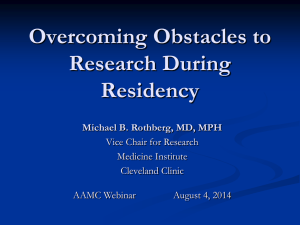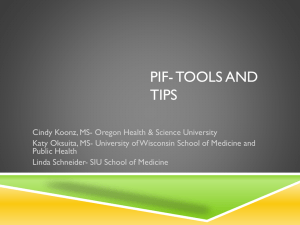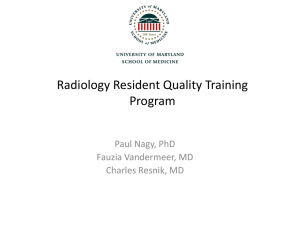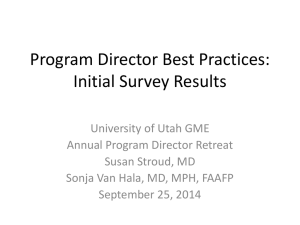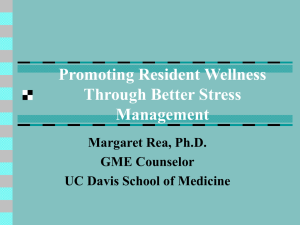Application Guide
advertisement
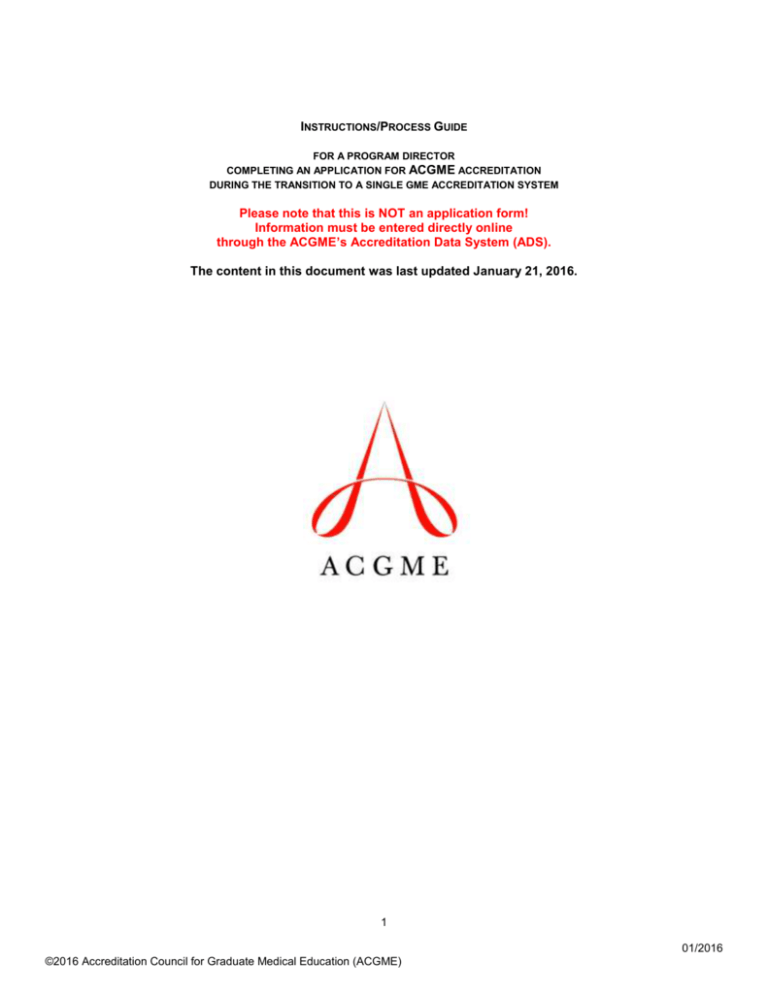
INSTRUCTIONS/PROCESS GUIDE FOR A PROGRAM DIRECTOR COMPLETING AN APPLICATION FOR ACGME ACCREDITATION DURING THE TRANSITION TO A SINGLE GME ACCREDITATION SYSTEM Please note that this is NOT an application form! Information must be entered directly online through the ACGME’s Accreditation Data System (ADS). The content in this document was last updated January 21, 2016. 1 01/2016 ©2016 Accreditation Council for Graduate Medical Education (ACGME) Introduction: Before beginning the application process, please review the applicable Program Requirements and FAQs available on the specialty Review Committee’s web page, and contact the Review Committee Executive Director with any questions regarding the Requirements or the application process. STEP 0: Initiate Application / Enter Basic Information (to be completed by the DIO) Initiate Application To initiate an application for a previously approved AOA program under the terms of the Single Accreditation System, first click “Yes,” then enter the six-digit previous AOA Program ID: The DIO must click “Yes” and enter the six-digit AOA Program ID for the program. Proceed Enter Basic Information What is the planned start date for the first class of residents/fellows? If there are residents/fellows currently enrolled in the program, it is suggested that the program enter July 1 of the current academic year. The Review Committee will determine whether Initial Accreditation will be effective on the date that the decision to grant Initial Accreditation is made or July 1 of the academic year in which the decision is made. Length of accredited resident/fellow training (in years): (This drop-down menu is limited to only the appropriate responses. For example, an anesthesiology program can be three years or four years in length, depending on whether the clinical base year is incorporated into the program. For internal medicine, the program can only be three years, so only “3” will be available in the drop-down menu.) Does this program currently have residents/fellows? (Yes/No) The answer to this question will trigger one of the following for Step 10. Yes = Your DIO has indicated that there are residents/fellows within this program. Data must be provided for the residents/fellows currently participating in the program. No = The DIO has indicated the program does not have current residents/fellows. 2 01/2016 ©2016 Accreditation Council for Graduate Medical Education (ACGME) STEP 1: Select the Participating Sites (to be completed by the DIO) 1. Provide the following information for each site. Note: The DIO need enter only one site to initiate the application; other sites may be added, and information may be edited, throughout the application process (prior to submission). Site Name: Primary Teaching Site: (Yes/No) Required Rotation: (Yes/No) Do all residents rotate through this site? (Yes/No) Program Letter of Agreement (PLA) exists between program and site? ((Yes/No/NA) Rotation Months (by level) Y1: Y2: Y3: Distance to Primary Teaching Facility: Miles: Minutes: Briefly describe the content of the educational experience (addressing faculty coverage, volume/variety of clinical experience, site support and educational impact): Which of the following are available within your institution for residents (check all that apply): □ Sleeping Rooms □ Shower □ Secure areas (lockers or rooms that can be locked) □ Cafeteria □ Vending machines □ Parking within 5 minutes of facility □ Wifi □ None of the Above 2. If the total number of rotation months per year does not equate to 12 months (for all sites combined), provide an explanation: 3 01/2016 ©2016 Accreditation Council for Graduate Medical Education (ACGME) STEP 2: Select the Program Director (to be initiated by the DIO and completed by the Program Director) General Information Salutation: First Name: Middle Initial: Last Name: Suffix: Degrees: Title: E-mail address for communicating with ACGME: National Provider ID: E-mail address to be used as a secondary point of contact: Phone Number: Extension: Fax Number: Primary Institution (dropdown populated by sites entered in Step 1): Date First Appointed Faculty Member in this program: Date First Appointed Program Director: Term of Appointment: Year Started Teaching in this Specialty: Is also Chair of Department? Medical School Type of medical school (US-LCME-Accredited, COCA-Accredited, Canadian, International, or US non-accredited): Please select country (drop-down of countries if International is selected for type above): Name of medical school (drop-down based on type/country selected above): Medical School Graduation Year: Other School Name (if not listed in dropdown above): Specialty / Field Specialty: Other Specialty: (List all specialty certifications—there is no limit—and include the following information for each.) If applicable, include multiple certifications for the same specialty, such as certification by an American Board of Medical Specialties (ABMS) member board or an AOA certifying board. Certification Type (ABMS, AOA, RCPSC, or Other): Original Certification Year: Certification Status (Re-Certified, Original Currently Valid, Lapsed, Time-Unlimited/No Recert, Meets MOC): Re-Certification Year (enter most recent past, not next upcoming): Explain Equivalent Qualifications for Review Committee Consideration: Faculty Hours Number of hours per week faculty member devotes to this program's activities in the following: Clinical supervision of residents Administration of the program Research/scholarly activity with residents Didactics/teaching with residents Total hours devoted to this program Note: After the DIO completes the information through Step 2, an e-mail is sent to the program director with an ADS link and program director login details. The program director then reviews and confirms the information, allowing access to all subsequent steps (which need not be completed sequentially). More information for the program director will be entered later—see Step 9. 4 01/2016 ©2016 Accreditation Council for Graduate Medical Education (ACGME) STEP 3: Update Program Details Be sure to update the basic program information, including the address. Note: This information will be displayed on the ACGME public site. 1. Program Information Address: Website Address: Public Contact e-mail/Director’s external e-mail: External Comments: 2. Accreditation Information Does the program require additional year beyond accredited program length? Does the program offer preliminary/other positions? Does the program require prior or additional GME training? (If so, how many years?) 5 01/2016 ©2016 Accreditation Council for Graduate Medical Education (ACGME) STEP 4: Add Other Program Personnel You are required to enter at least one program coordinator (max. 2). You may also add a Department Chair, and if the program director is not certified by an ABMS member board, you may enter a co-program director. Coordinator 1 Salutation: First Name: Middle Initial: Last Name: Suffix: Degrees: Title: Phone Number: Extension: Fax Number: E-mail Address: Coordinator 2 (optional) Salutation: First Name: Middle Initial: Last Name: Suffix: Degrees: Title: Phone Number: Extension: Fax Number: E-mail Address: Department Chair (optional) Salutation: First Name: Middle Initial: Last Name: Suffix: Degrees: Title: Phone Number: Extension: Fax Number: E-mail Address: 6 01/2016 ©2016 Accreditation Council for Graduate Medical Education (ACGME) STEP 5: Update ACGME Requested/Filled Resident Positions Enter the number of resident positions being requested, as well as the number of currently filled positions. Number of ACGME Requested Positions: Number of Filled Positions: 7 01/2016 ©2016 Accreditation Council for Graduate Medical Education (ACGME) STEP 6: Update Duty Hour Info DUTY HOUR, PATIENT SAFETY, AND LEARNING ENVIRONMENT Briefly describe your back-up system when clinical care needs exceed the residents' ability. Briefly describe how clinical assignments are designed to minimize the number of transitions in patient care. Briefly describe how the program director and faculty evaluate the resident's abilities to determine progressive authority and responsibility, conditional independence and a supervisory role in patient care. Excluding call from home, what is the projected averaged number of hours on duty per week per resident, inclusive of all house call and all moonlighting? During regular daytime hours, indicate which of the following back-up systems your program will have in place when clinical care needs exceed the resident's ability. Check up to 3 options. □ Physicians are immediately available (on site) □ Physicians are available by phone □ Senior Residents or Fellows are immediately available (on site) □ Senior Residents or Fellows are available by phone □ Mid-level Providers are immediately available (on site) □ Mid-level Providers are available by phone □ No back-up system □ Other During nights and weekends, indicate which of the following back-up systems your program will have in place when clinical care needs exceed the resident's ability. Check up to 3 options. □ Physicians are immediately available (on site) □ Physicians are available by phone □ Senior Residents or Fellows are immediately available (on site) □ Senior Residents or Fellows are available by phone □ Mid-level Providers are immediately available (on site) □ Mid-level Providers are available by phone □ No back-up system □ Other Indicate which methods the program will use to ensure that hand-over processes facilitate both continuity of care and patient safety? Select all that apply. □ Hand-over form (a stand-alone or part of an electronic medical record system) □ Paper hand-over form □ Hand-over tutorial (web-based or self-directed) □ Scheduled face-to-face handoff meetings □ Direct (in person) faculty supervision of hand-over □ Indirect (via phone or electronic means) hand-over supervision □ Senior Resident supervision of junior residents □ Hand-over education program (lecture-based) □ Other Indicate the ways that your program will educate residents to recognize the signs of fatigue and sleep deprivation. Select all that apply. 8 01/2016 ©2016 Accreditation Council for Graduate Medical Education (ACGME) □ Didactics/lecture □ Computer based learning modules □ Grand rounds □ Small group seminars or discussion □ Simulated patient encounters □ On-the-job training □ One-on-one experiences with faculty and attendings □ Other Which of the following options will the program or institution offer residents who may be too fatigued to safely return home? Choose the most frequently used option. □ Money for taxi □ Money for public transportation □ One-way transportation service (such as a dedicated facility bus service) □ Transportation service which includes option to return to the hospital or facility the next day □ Reliance on other staff or residents to provide transport □ Sleeping rooms available for residents post call □ Not applicable: residents do not take in-house call □ Other Are residents permitted to moonlight? If yes, under what circumstances? On average, will residents have one full day out of seven free from educational and clinical responsibilities? What will be the maximum number of consecutive nights of night float assigned to any resident in the program? On the most demanding rotation, what will be the frequency of in house call? If residents at different levels are given different frequencies of in-house call, please choose the most frequent schedule. Will the program use ambulatory and/or non-hospital settings in the education of residents (experiences other than inpatient)? Yes/No If yes, indicate the type of settings that will be used. Select all that apply. □ Hospital-Based Continuity Clinic □ Community or Federal Public Health Centers □ Ambulatory Surgery Centers (Surgical or specialty centers) □ Veterans Administration (VA) Ambulatory Services □ Faculty Ambulatory Practice, Institutionally-Based □ Private Physician's Offices □ Ambulatory / outpatient settings □ Other Do you use an electronic medical record in your primary teaching hospital? Yes/No If yes, what percentage of your residents will use the electronic medical record system to improve the health in a population of patients (e.g., determining the appropriate protocol for a specific chronic illness stage, assessing symptoms or treatment patterns in ambulatory clinic, improving preventive care, etc.)? 9 01/2016 ©2016 Accreditation Council for Graduate Medical Education (ACGME) STEP 7: Update Additional Application Questions PROGRAM RESOURCES How will the program ensure that faculty members (physician and non-physician) have sufficient time to supervise and teach residents? Please mention time spent in activities such as conferences, rounds, journal clubs, etc., if relevant. Briefly describe the educational and clinical resources available for resident education. RESIDENT APPOINTMENTS *The term resident is used to describe any physician in graduate medical education; this includes interns, residents, subspecialty residents, and fellows. Describe how the residents will be informed about their assignments and duties during residency. [The answer must confirm that there are skills and competencies for each assignment and for each year, and that these will be readily available (hard copy, electronically, listserv, etc.) to all residents.] Will there be other learners (including, but not limited to, residents from other specialties or other programs in the same specialty, subspecialty fellows, nurse practitioners, PhD or MD students) in the program sharing educational or clinical experiences with the residents? If yes, describe the impact those other learners will have on the program's residents. Describe how the program will handle complaints or concerns the residents raise with faculty members or the program director. (The answer must describe the mechanism by which individual residents can address concerns in a confidential and protected manner, as well as steps taken to minimize fear of intimidation or retaliation.) RESIDENT SCHOLARLY ACTIVITIES Will the program offer residents the opportunity to participate in scholarly activities? If yes, briefly describe the opportunity and the expectations about residents' participation. 10 01/2016 ©2016 Accreditation Council for Graduate Medical Education (ACGME) STEP 8: Overall Evaluation Methods Please complete the questionnaire on the overall evaluation methods used by this program. Using the tool below, provide the methods of evaluation used for assessing resident competence in each of the six required ACGME competencies, and identify the evaluators for each method (e.g., If performance in patient care is evaluated at the end of a rotation using a global form completed by faculty and senior residents and also using a checklist to evaluate observed histories and physicals by the ward attending and continuity clinic preceptor, then under patient care select global assessment for a method and faculty member and senior resident for evaluators. Then add patient care again as a competency and select “Direct observation” for a method and “Faculty Member” as the evaluator). List all that apply; include at least two assessment methods for each competency. This table will expand online to accommodate as many rows as necessary. Competency Assessment Method Evaluator(s) Drop-down includes the six competencies: Interpersonal and Communication Skills Medical Knowledge Patient Care Practice-based Learning and Improvement Professionalism Systems-based Practice Checkboxes: □ Allied Health Professional □ Chief/Supervising Resident □ Clerical Staff □ Consultants □ Evaluation Committee □ Faculty Member □ Junior Resident/Medical Student □ Nurse □ Other □ Patient/Family Member □ Peer Resident □ Program Director □ Self □ Technicians Example: Patient Care Drop-down includes the following: Anatomic or animal models Direct observation Global assessment In-house written examination In-training examination Multisource assessment Objective structured clinical examination Oral Examination Other Patient survey Practice/billing audit Project assessment Record/chart review Resident experience narrative Review of case or procedure log Review of drug prescribing Review of patient outcomes Role-play or simulations Simulations/models Standardized patient examinations Structured case discussions Videotaped/recorded assessment Global assessment Example: Patient Care Direct observation ■ Faculty Member ■ Chief/Supervising Resident ■ Faculty Member 11 01/2016 ©2016 Accreditation Council for Graduate Medical Education (ACGME) List other key assessment methods used but not available in the drop-down list above (leave blank if not applicable). Does the program have a system in place to evaluate the resident/fellows' abilities to determine whether they may take on progressive authority and responsibilities in patient care? Yes/No Indicate how evaluators are educated to use the assessment methods listed above so that residents/fellows are evaluated fairly and consistently. Select up to 3 of the most commonly used methods. □ Workshops/special training on assessment □ Informal or formal discussions among the faculty □ Assessment is a topic of a retreat □ Faculty review assessments and compare evaluations □ Program director instructs or educates about assessment methods □ Group or committee discussions that result in consensus assessment of residents □ None, no specific education on assessment provided □ Other (specify below) Specify only if “Other” is selected Indicate how residents/fellows are informed of the performance criteria on which they will be evaluated. Check all that apply. □ During resident orientation □ General goals and objectives □ Rotation-specific goals and objectives □ Provided handouts or examples of evaluation forms □ Other written communications □ Verbal communication or meetings □ Reviewed with residents before each rotation □ Reviewed with residents at the beginning of each year □ Residents not informed □ Other (specify below) Specify only if “Other” is selected Does the program have a Clinical Competency Committee? Describe the system that ensures faculty members will complete written evaluations of residents/fellows in a timely manner following each rotation or educational experience? 12 01/2016 ©2016 Accreditation Council for Graduate Medical Education (ACGME) STEP 9: Update Faculty Info Physician Faculty Instructions List in the following order: program director*, program chair, associate program director(s), all core physician faculty members (all core physician faculty must be listed in alphabetical order by institution). Use the 'title' field in the roster to identify the faculty member's role in the program (e.g., program director, associate program director, etc.). *Note: Only some of this information (General Information, Medical School, Specialty/Field, and Faculty Hours) was entered for the program director in Step 2. The rest of the information should be entered as part of Step 9). [A table listing the Faculty Roster instructions by specialty is available here.] A CV is required for the program director and each active physician faculty member that has been designated as a core faculty member on your roster. Any physician faculty member who functions as both a core faculty member and a subspecialty education coordinator should be included in this table. General Information Salutation: First Name: Middle Initial: Last Name: Suffix: Degrees: Title: E-mail address for communicating with ACGME: National Provider ID: Primary Institution (drop-down populated by sites entered): Date First Appointed Faculty Member in this program: Year Started Teaching in this Specialty: Is also Chair of Department? Medical School Type of medical school (US-LCME-accredited, COCA-accredited, Canadian, International, or US non-accredited): Please select country (drop-down of countries if International is selected for type above): Name of medical school (drop-down based on type/country selected above): Medical School Graduation Year: Other School Name (if not listed in drop-down above): Specialty / Field Specialty: Other Specialty: (List all specialty certifications—there is no limit—and include the following information for each.) Certification Type (ABMS, AOA, RCPSC, or Other): Original Certification Year: Certification Status (Re-Certified, Original Currently Valid, Lapsed, Time-Unlimited/No Recert, Meets MOC): Re-Certification Year (enter most recent past, not next upcoming): Explain Equivalent Qualifications for Review Committee Consideration: Faculty Hours Number of hours per week faculty member devotes to this program's activities in the following: Clinical supervision of residents Administration of the program Research/scholarly activity with residents Didactics/teaching with residents 13 01/2016 ©2016 Accreditation Council for Graduate Medical Education (ACGME) Total hours devoted to this program Graduate Medical Education Program Name: Specialty: From: To: Licensures State / Province: Expiration: Academic Appointments Please list the past 10 years of academic appointments (employment), beginning with your current position. Position: From: To: Concise Summary of Role/Responsibilities in Program Current Professional Activities / Committees Please list up to 10 activities and committees within the past five years. Activity: From: To: Bibliographies Please list the most representative Peer-Reviewed Publications / Journal Articles from the last five years, with a limit of 10. Separate entries with a double line break. Do not leave blank. If none, please enter NONE. Articles Please list selected review articles, chapters, and/or textbooks from the past five years, with a limit of 10. Participation in Local, Regional, and National Activities / Presentations / Abstracts / Grants - this does not include attending a meeting or conference. Please list participation in local, regional and national activities/presentations from the past five years, with a limit of 10. 14 01/2016 ©2016 Accreditation Council for Graduate Medical Education (ACGME) STEP 10: View/Update Residents Complete for each resident. (If applicable. Whether there are residents in the program was indicated by the DIO when the application was initiated— see Step 0.) 1. Resident Information First Name: Middle Initial: Last Name: Suffix: Social Security Number: Date of Birth: National Provider ID: Medical school from which this resident graduated: Month/Year Degree Received: 2. Resident Status (pick one) □ Active Full-time □ Active Part-time □ Started Program Off-Cycle □ In Program but Doing Research/Other Training (intends to resume accredited training in this program) □ Not in Program Yet and/or Doing Preliminary Year Elsewhere □ Leave of Absence 3. Resident Details Type of Position: (Preliminary or Categorical) Preliminary Designated Positions: Positions for residents who have already been accepted into another specialty, but who are completing prerequisites for that specialty (see Program Requirements for Surgery). Preliminary Non-Designated Positions: Positions for residents who at the time of admission to a program have not been accepted into any specialty (see Program Requirements for Surgery). Categorical: A resident who enters a program with the objective of completing the entire program. Year in Program: E-mail Address: Start Date: Expected Completion: Did this resident have prior training in another accredited/approved program (other than in this program)? If yes, enter years of most recent training in accredited/approved program: Did this resident start the program in year one (at the beginning of the program - no transfer credit)? (Yes/No) Gender: Ethnicity: 15 01/2016 ©2016 Accreditation Council for Graduate Medical Education (ACGME) STEP 11: Download and Complete the Specialty-Specific Application Download and complete the MS Word specialty-specific application document from the ACGME web page for the applicable specialty. Once completed, convert it to a PDF to be uploaded with the other application attachments in Step 12. 16 01/2016 ©2016 Accreditation Council for Graduate Medical Education (ACGME) STEP 12: Upload Application Attachments Attachment: Policy for Supervision of Residents Policy for supervision of residents (addresses residents’ responsibilities for patient care and progressive responsibility for patient management and faculty member responsibilities for supervision). [IR III.B.4] Attachment: Program Policies and Procedures Program policies and procedures for resident duty hours and work environment, including policies on moonlighting. [CPR II.A.4.j; CPR VI.G; IR IV.J] Attachment: Overall Educational Goals Overall educational goals for the program. [CPR IV.A.1] Attachment: Competency Goals and Objectives and Faculty Evaluation of Residents A sample of competency-based goals and objectives for one assignment at each educational level [CPR IV.A.2], a blank copy of the forms that will be used to evaluate residents at the completion of each assignment. [CPR V.A.1.a] Attachment: Letters of Agreement All Program Letters of Agreement (PLAs) with participating sites. [CPR I.B.1] Attachment: Semiannual and Summative Evaluations A blank copy of the form that will be used to document the semiannual evaluation of the residents with feedback. [CPR V.A.2.b.(4)], and a blank copy of the final (summative) evaluation of residents, documenting performance during the final period of education and verifying that the resident has demonstrated sufficient competence to enter practice without direct supervision. [CPR V.A.3] Attachment: Program-specific Evaluation Tools Blank copies of tools the program will use to provide objective assessments of competence in patient care, medical knowledge, practice-based learning and improvement, interpersonal and communication skills, professionalism, and systems-based practice. [CPR V.A.2.b.(1)] For multiple tools, create one PDF. Attachment: Forms Used for Faculty and Program Evaluation Blank copies of forms that residents will use to evaluate the faculty and the program. [CPR V.B.3; CPR V.C.2.d.(1)] Attachment: Sample Block Diagram Provide a sample block diagram for each year of training. Use number of months for each block rotation. See Appendix for block diagram instructions and sample. Attachment: Specialty-specific Application Questions Complete the Specialty-specific Application and upload it here. This document can be found under the "New Applications" heading on the specialty page on the ACGME website. 17 01/2016 ©2016 Accreditation Council for Graduate Medical Education (ACGME) STEP 13: Review Application Please review and print a copy of your application for your records. Enter any missing information that has not yet been entered. You will not be able to submit your application if any of the above steps are incomplete or there is information missing on your application. 18 01/2016 ©2016 Accreditation Council for Graduate Medical Education (ACGME) STEP 14: Verify and Submit Application to DIO After clicking “Verify Application and Submit to DIO” button in the header, your application will be submitted to your DIO for review and final submission. After verification, the DIO will electronically submit the application to the ACGME. Applications can only be submitted to the DIO by the program director. (Program coordinators cannot submit new applications.) The Review Committee does not have access to the application until it has been submitted by the DIO. Once the DIO has submitted the application to the ACGME for final review, it cannot be changed, altered, or amended. Please contact your Review Committee Executive Director with questions. Contact information for additional Review Committee staff is provided on the specialty web page on the ACGME website. 19 01/2016 ©2016 Accreditation Council for Graduate Medical Education (ACGME) Appendix Appendix 1 20 01/2016 ©2016 Accreditation Council for Graduate Medical Education (ACGME) 21 01/2016 ©2016 Accreditation Council for Graduate Medical Education (ACGME)

